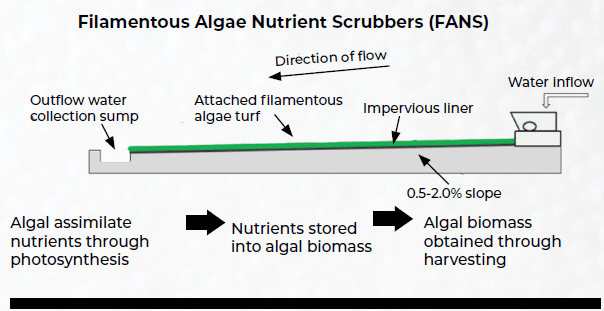Research is underway to assess the use of algae in agricultural drainage systems to recover nutrients.
FILAMENTOUS ALGAE Nutrient Scrubbers (FANS) are a novel agricultural drainage treatment system that grows filamentous algae to recover nutrients for beneficial use.
Rupert Craggs and Harizah Hariz from NIWA Hamilton presented research at the Farmed Landscapes Research Centre conference in Palmerston North last month on the novel system, widely used in the United States where they have been used to treat various agricultural effluents and wastewaters.
MBIE-funded New Zealand research has shown annual nutrient removal rates in excess of 130g Nitrate-N/ square metre/year and 20g DRP (dissolved reactive phosphate) /m2/ year, in line with results from the US and at least double that of similar nutrient removal in constructed wetlands for N (40g TN/m2/year) and four times that of P (3g/m²/year).
FANS are gently sloping floways that are covered with filamentous algae. The water flows down the floway and over or through the algae and is treated through a combination of algal photosynthesis and growth (nutrient assimilation, oxygenation) and physical filtration (settling, adsorption and precipitation.)
Craggs said they have investigated different options for attached algal systems including alongside the waterway or within the existing freshwater body (streams, rivers and lakes).

They have also worked on beneficial use of the nutrients recovered as algal biomass and on determining what would be a culturally acceptable use of the biomass (e.g. fertiliser or animal fodder). Annual results from pilot scale demonstration trials have shown seasonal variation of production between 5 and 15 g/m²/day.
Harizah Hariz presented her findings on research into an onfarm performance of pilot scale FANS over seven months, on a Morrinsville dairy farm, comparing the effects of seeding methods (controlled seeding vs. natural establishment) and seeded species (single target species vs. mixed algae assemblage).
The pilot trial FANS had channels set up with three different water depths to determine the best depth for algal growth. They were seeded with filamentous algae from streams near the trial sites, including Oedogonium,
Spirogyra, Rhyzoclonium and Cladophora.
As the drainage flows down the channel, the algae assimilate dissolved nitrogen and phosphorus from the water into algal biomass.
The trials were situated on farms owned by Tainui Group Holdings and the Paeahu Trust.
Water samples were taken at the inflow and outflow points of the FANS channels weekly to assess the nutrient concentrations before and after the treatment. These data determined the mass of nutrients the algae can remove. The nutrient-removal performance of the FANS system can then be compared against the performance of other nutrient pollution mitigation technologies such as wetlands, woodchip bioreactors and riparian management.
Results point to mixed species
Oedogonium sp. was selected as the target species for FANS due to its best biomass productivity and nutrient removal performance under ambient summer and winter conditions in comparison to other tested single species cultivated on FANS, Hariz said.
Controlled seeding promoted faster biomass establishment on FANS than the natural establishment method.
However mixed species had higher nutrient removal than single species: mixed species adapted to farm ambient conditions/drainage water in comparison to newly introduced algae species.
Therefore seeding single species may not be required to improve biomass production and nutrient removal, Hariz said.
What’s next:
A FANS system can be established in a few weeks and be operational soon after, much faster than a constructed wetland, Craggs said.
But it requires more regular maintenance than a wetland, as the algal biomass needs to be periodically harvested.
The five-year FANS project is now into its third year and the data acquired to date suggests these systems could be widely applicable to a range of land types and nutrient loads.
Larger trial sites will be established and tested during the 2022-23 financial year. The project is scheduled for completion in 2024.





